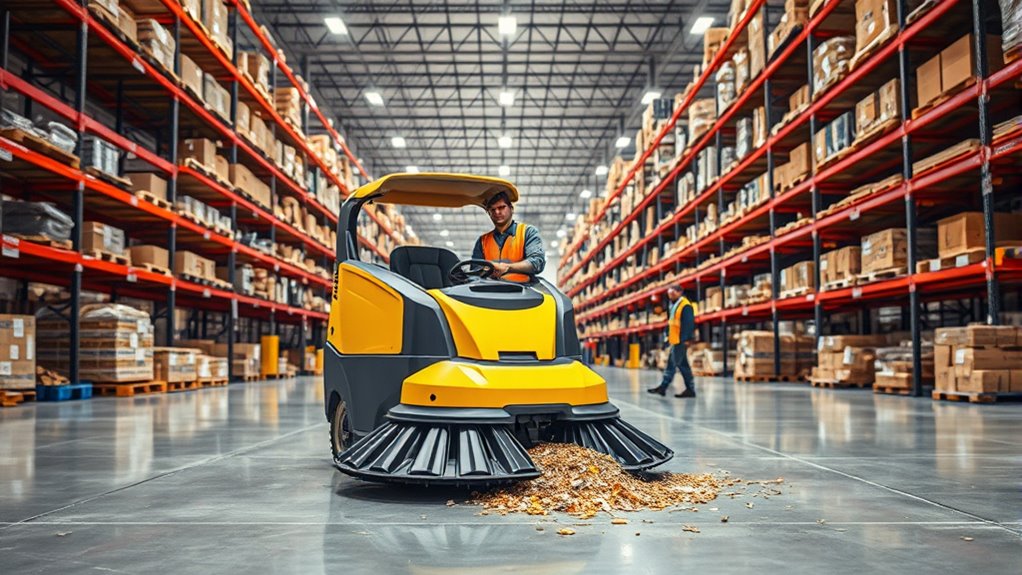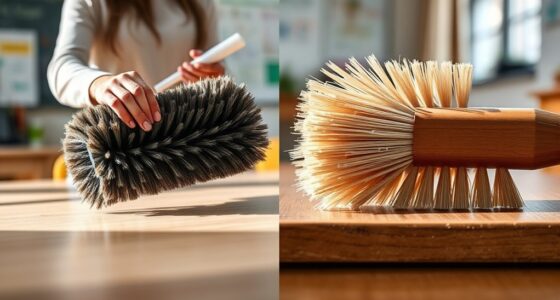Industrial sweepers for warehouses and plants now feature robotic and autonomous technology, making cleaning more efficient and thorough. Using sensors and advanced algorithms, these machines navigate complex layouts, operate during off-hours, and reduce manual labor. Regular maintenance, proper scheduling, and staff training guarantee they perform at their best and last longer. Incorporating these innovative sweepers can transform your cleaning routines and safety standards—discover how to optimize their use for your facility.
Key Takeaways
- Modern industrial sweepers feature autonomous navigation, sensors, and algorithms for efficient cleaning in complex warehouse layouts.
- Robotic sweepers enhance productivity, reduce manual labor, and operate during off-hours to maintain cleanliness without disrupting workflows.
- Regular maintenance of batteries, sensors, brushes, and software is essential for optimal performance and prolonging equipment lifespan.
- Integration of robotic sweepers with manual cleaning ensures comprehensive coverage, especially in hard-to-reach or stubborn debris areas.
- Implementing advanced cleaning technology and proper maintenance creates safer, cleaner, and more efficient warehouse and plant environments.

Have you ever wondered how large industrial spaces keep their floors spotless and safe for workers? The answer often lies in the smart use of industrial sweepers, which are designed to handle vast areas efficiently. One of the key advancements in this field is robotic integration. Modern industrial sweepers now come equipped with autonomous capabilities, allowing them to navigate complex warehouse layouts or manufacturing plants without constant human oversight. These robotic systems use sensors and advanced algorithms to detect obstacles, map their environment, and plan ideal cleaning routes. This technology not only boosts productivity but also guarantees thorough cleaning with minimal interruption to daily operations. You can program these sweepers to operate during off-hours, maintaining a consistently clean environment without disrupting workflows.
Robotic industrial sweepers enhance efficiency and cleanliness with autonomous navigation and minimal disruption.
However, integrating robots into your cleaning routine requires attention to maintenance protocols. Regular maintenance is essential to keep these machines running smoothly and to extend their lifespan. It involves routine checks of batteries, motors, brushes, and sensors to prevent breakdowns. Many manufacturers recommend daily inspections for common wear items and more comprehensive servicing weekly or monthly. Following strict maintenance protocols helps identify potential issues early, reducing downtime and costly repairs. Keep a detailed log of maintenance activities and adhere to the manufacturer’s guidelines for parts replacement and software updates. Staying proactive with maintenance ensures your robotic sweepers perform at peak efficiency, saving you money in the long run and safeguarding your investment.
In addition to robotic integration, you should consider the overall design of your cleaning program. Automated sweepers can be programmed to follow specific schedules, but you need to coordinate this with manual cleaning tasks to cover all areas effectively. For heavily trafficked zones, manual or specialized cleaning might still be necessary to reach corners or stubborn debris that robots might miss. Training your team on how to operate and troubleshoot robotic sweepers is essential too, ensuring everyone understands the importance of regular maintenance and proper use.
Ultimately, the combination of robotic integration and strict maintenance protocols revolutionizes industrial cleaning. It allows you to maintain a safer, cleaner environment with less effort and greater consistency. By investing in these advanced cleaning solutions and staying diligent with their upkeep, you’ll create a workspace that’s not only spotless but also more efficient and safer for everyone involved.
Frequently Asked Questions
What Are the Maintenance Requirements for Industrial Sweepers?
To keep your industrial sweeper running smoothly, follow a regular cleaning schedule, including daily checks of brushes and squeegees. You should also perform filter maintenance by inspecting and replacing filters as needed to guarantee peak suction. Keep an eye on the battery or power source, and lubricate moving parts periodically. Consistent maintenance prevents breakdowns, extends the sweeper’s lifespan, and maintains cleaning efficiency.
How Do I Choose the Right Sweeper for My Facility?
Choosing the right sweeper is like finding the perfect puzzle piece for your facility. You should consider sweeper size to match your space and workload, ensuring efficiency without excess. Battery options matter too; decide between standard or extended-life batteries based on your operational hours. Assess your cleaning needs, space constraints, and budget to make an informed decision, so your sweeper seamlessly fits into your workflow like a puzzle piece snapping into place.
What Safety Features Are Included in Modern Industrial Sweepers?
Modern industrial sweepers include essential safety features like safety protocols and emergency stop buttons, ensuring your safety during operation. You can quickly halt the machine if needed, preventing accidents or damage. Many sweepers also have safety guards, warning lights, and sensors to detect obstacles, helping you operate confidently and securely. These features work together to create a safer environment for you and your team while maintaining efficient cleaning.
Can Industrial Sweepers Operate on Uneven Surfaces?
Yes, modern industrial sweepers can operate on uneven surfaces thanks to their surface adaptability features. They are designed with adjustable brushes and flexible wheels that help navigate uneven terrain or rough surfaces. This allows you to efficiently clean various environments without worrying about stability or effectiveness. So, whether you’re dealing with uneven terrain or challenging surfaces, these sweepers provide reliable performance and smooth operation, making your cleaning tasks easier and more effective.
What Is the Average Lifespan of an Industrial Sweeper?
You can expect an industrial sweeper to last around 5 to 10 years with proper maintenance. Warranty coverage plays a key role in protecting your investment, often covering repairs during this period. Regular upkeep reduces environmental impact by extending its lifespan and ensuring efficient operation. Keep in mind that usage intensity and operating conditions can influence longevity, so staying proactive helps maximize your sweeper’s durability and sustainability.
Conclusion
In choosing the right industrial sweeper, you’re investing in efficiency and safety—no need for a DeLorean to see a cleaner, more productive space. With the right equipment, you’ll keep your warehouse running smoothly, just like clockwork. Remember, even as technology advances, the core goal remains the same: a cleaner environment fuels your success. So, don’t wait for a future that’s already here—start sweeping smarter today.









